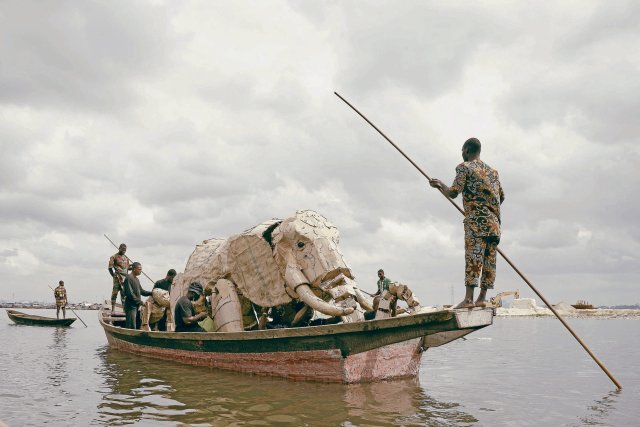Make global warming in concrete terms: part of “The Herds” on the way on the Makoko river near Lagos
Photo: Kashope FAJE/88 LIFE STUDIO
A large procession of plywood and portrait figures is currently drawn through Africa and Europe: giraffes, kudus, gorillas, chimpanzees, gazelles, zebras, wolves, bears, hyenas, leopards, elephants, antelopes- a total of over 600 life-size animal figures that are encouraged by puppet players. “” The Herds “is a story about humanity that is currently losing control,” said the artistic director Amir Nizar Zuabi. A loss of control caused by the ignorance of the consequences of industrialization and carbonization that has been known for decades.
The animals are on the run from global warming. They run to draw attention to the climate catastrophe. They are much more concrete than “global warming”, attract thousands of enthusiastic spectators at every place and are the result of an enormous vision and a huge logistical apparatus with hundreds of participants, partner organizations, volunteers, sponsors and supporters from numerous countries.
It took years of preparation for the whole undertaking, starting with exact studies, how the animals run, eat, stand, stand, sleep, to build models, develop cutting plans and construction instructions to the training of over 1200 puppet players and much more.
“The Herds” have already had various stations: Kinshasa, Lagos, Dakar, Casablanca, Cadiz, Madrid, London, Manchester – and a total of around 20,000 kilometers, which will be covered from April to August 2025. They are packed, shipped, unpacked, re -packed, reorganized or reproduced or newly created in the respective locations. Other animals are added at each station, adapted to the respective fauna. Even hedgehogs and fish are considered. “The Herds” almost came to Germany, but a German theater institution had canceled the collaboration – without reason.
The animal dolls were developed by the Ukwanda Puppets and Designs Art Collective, which is located in a humanities research center in Cape Town, the Center for the Humanities Research (Chr) of the University of the Western Cape, in South Africa. The research center, the collective and Zuabi and its team share a mission that “The Herds” has sent on their journey: at a time of indifference, ruled by statistics and forecasts, in a time of slow, now also noticeable, but still not perceived, threatening violence that combines with the global warming, is the challenge of creating a sensual experience and sensitizing and At best, encouraged to act.
Nobody who sees “The Herds” will remain unaffected by the amazing troop, the attention to detail of production and the entire undertaking. It is one of the most extensive productions in public space that combines qua empathy and enthusiasm hundreds of people across countries and continents, be it as players, spectators or other people involved. The actors develop additional workshops or educational programs up to a website (www.theherds.org), which contains numerous suggestions on how to get involved locally. And last but not least, there is a decarbonization certificate for cities that have been ratified by Heidelberg in Germany.
Nd.Diewoche – Our weekly newsletter

With our weekly newsletter Organization Look at the most important topics of the week and read them Highlights our Saturday edition on Friday. Get the free subscription here.
“The Herds” is more about admiring the artistry. And it is also about more than drawing attention to the climate catastrophe. The main question is how you do. Art will not invent anything to make destruction processes reversible. Art does not offer a “solution” of the climate problem. But art can promote what the philosopher Baruch de Spinoza called happy passions when he differentiated them from the sad passions.
Fascinating dolls in their intermediate position of lifeless material and liveliness, reinforced by the fact that they are animals to which a lighter empathy relationship can be built up. Anyone who has ever seen the film “Au Hazard Balthazar” (1966) by Robert Bresson will hopefully never shine animals or other beings again. And maybe qua “The Herds” arises to an overcome to the banal fact that people are also animals.
Zuabi has already made dolls into ambassadors in a previous project. Since 2021 Little Amal, an almost four meter tall puppet in the form of a girl fled from Syria, has been touring a wide variety of countries. Most recently she was seen in Chile. Anyone who excludes such mammoth projects must believe in the possibility of art to be able to align something.
It is probably no coincidence that two of the main participants gained their theater experience in places where art is existential, since they conflict with beauty, situational forgetting and lightness through the respective conditions, even if the negotiated topics are catastrophic. Amir Nizar Zuabi was born in Eastern Jerusalem, son of Jewish-Palestinian parents, who in turn could escape Nazi Germany, and made theater in Palestinian refugee camps.
The Ukwanda Puppets and Designs Art Collective from South Africa, in turn, works in a country that is still deeply shaped by the traces of this violent separation after the official end of apartheid. The South African historian Premesh Lalu, who brought the art collective to the Chr in Cape Town, describes in his book »Undoing Apartheid«, as Apartheid was not just a juridical apparatus that ended in 1994, but also shaped everyday life down to the smallest detail and into every sensation. In the form of the “Petty Apartheid” – something like little apartheid – this still blocks this life -affirmative forces and is responsible for a persistent life experience of racial separation. As specific as these historical-political contexts may be, it combines something that can also be transferred to other contexts: a fundamental anesthetization, derived from anesthesia, i.e. an anesthetic of the senses.
This means an impoverishment in the tab of possible experiences, a impoverishment of social cohesion and the opportunities for life, which are based in politics and their technologies that rely on division and separation. The sudden increase in hate speeches in (a) social media would be another example of such a technology. “The Herds” is a way to oppose this impoverishment, to expand the ability to act, instead of producing fainting experience, combining something about an affirmative reference to something. This does not replace political analysis, but art also plays with and on other registers. “The Herds” also run against these devices of the divisions.
From 27. to 29.6. in London, then in Manchester, Aarhus, Copenhagen, Stockholm and Trondheim.
